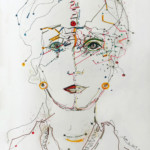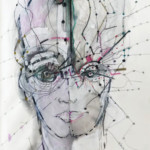Exhibition
in Berlin / Germany
- Colette: Berlin Night Drawing #31, 2018, mixed media, 42 cm x 29,3 cm
- Colette: Berlin Night Drawing #4, 2016, mixed media, 42 cm x 29,3 cm
- Colette: Berlin Night Drawing #5, 2016, mixed media, 42 cm x 29,3 cm
- Colette: Berlin Night Drawing #30, 2017, mixed media, 42 cm x 29,3 cm
To me, Colette’s “Berlin Night Drawings” look like cosmological maps, like Colette is trying to map the constellations of stars hypothetically appearing in, or comprising, our dreams. I can see Colette working on them in the middle of the night in Berlin, applying colorful glitter like stardust to the surface of the paper, or like metaphysical makeup, drawing lines as if she we were tracing the moon’s romance with the darkness inside us – and all of it emerging in forms so limpid and transparent, so full of light, their touch so facile, they would seem to come apart before they could lift off the page like exotic birds and butterflies destined for other worlds! And yet the lines hold firm, as delicate and strong and articulate as any Neo-Classical drawing by Ingres. If she is tracing the soul of a perfect stranger, then it is the soul of what is strange and exotic and forever elusive in all of us.
Colette’s “Berlin Night Drawings”, like her work in general, remind us that we are always putting ourselves together, that we are all like women, the Universal Woman (not entirely unrelated to de Kooning’s, and libidinally not really so much less grotesque), in front of an ontological mirror, gathering ourselves up into an image, a workable mask; that we are made of parts, a configuration, a topography, of connectible, if not connecting, lines; that there is no such thing as a whole, only abiding parts that never really fit together unless we patiently, and somewhat uninhibitedly, piece them together with few or no expectations, like micro-artists, knowing that at night we will wash the make-up away or that it will, most of it, simply wear off by the morning, like multi-colored mascara. We are all artists, as Beuys contended more than once, we are social creatures, we are all of us made up, like stories, determined by the forces surrounding us, but also compelled by the forces of intimacy. And we are all now, to riff on Warhol, potentially famous for the 15 seconds it takes for us to compose ourselves to snap a selfie. On the larger and deeper playing field, that is, for the sake of civilization, we wear the mask of civility, but we are also human, and inhuman, and therefore, driven by these external forces that shape us and by these internal forces (of intimacy) which we try, more often than not unsuccessfully, to shape. Forces that sometimes become more manifest at night, when we tend to let our guard down, and proximity with others and ourselves seems either more possible or less intimidating, depending on how we negotiate this comparably brutal and tender darkness.
But if we cast Colette as a mythic, Universal Lover versed in the civilizing arts of humanity, then we must see her also as an artist, a consummate creator of artifice, who sees beyond our individual needs and desires; hence, the emphasis she places on the eyes in each of her drawings. Sure, she compels us to see her, like a goddess steeped in the transcendental flounce of her costumes (who could miss her, unless we have an ideological axe to grind or a political agenda!); but she also insists upon seeing us, trapped, as we circumstantially are, by the self-reflexive gaze of the commonplace, which shapes not only what we see but how we see it. But her purpose is not to make us feel guilty; her modus operandi is to seduce us into the realization that we are all capable of transformation, even at the lowliest thresholds of deciding on what we will wear or not wear on any given day. Or, at the highest, deciding on who we will or will not be on the next. Decent or monstrous, compassionate or hateful, human or inhuman? Who shall we play on the diurnal stage of the common ground we must all stand on? She tells us it is up to us to see someone else in the mirror into which we steadily and often hopelessly stare. The drawings she makes during the proverbial “dark night of the soul” in Berlin, with its at times illustrious and at times despicable history, are portraits of us, and no one else, overflowing with nothing more than the clear, lucid, suggestive light of self-transformation! (from the essay Colette’s “Berlin Night Drawings” by Richard Milazzo)
New York City, April 8, 2018
Colette Justine better known as Colette and from 2001 Colette Lumiere is a multimedia artist (painter, sculptress, installation maker) known for her pioneering work in performance art, street art and her use of photography. She is also known for her work exploring male and female gender roles, different guises and personas and for her soft fabric environments where she often appears as the central element.
She was born in Tunis, Tunisia, of French nationality, and grew up in Nice, France before becoming a naturalized American citizen. She lives and works in New York City and Berlin.
She has recently had a solo show at MOMA PS1 (2016), her solo show 2017 at Mitchell Algus Gallery New York has been selected in Best of 2017 Art Forum Dec. Issue. 2016 she received the Guggenheim fellowship.
Gallery hours Tues-Fri 11 am 6 pm, Sat 11 am – 4 pm
Für mich sehen Colettes “Berliner Nachtzeichnungen” aus wie kosmologische Karten, als würde Colette versuchen, die Konstellationen der Sterne festzuhalten, die hypothetisch in unseren Träumen erscheinen – oder aus denen sie bestehen. Ich stelle mir vor, wie sie mitten in der Nacht in Berlin an ihnen arbeitet, wie sie farbigen Glitter wie Sternenstaub auf die Oberfläche des Papiers aufträgt oder gleich einem metaphysisches Make-up, wie sie Linien zieht also ob sie die Romantik des Mondscheins mit der Dunkelheit in uns verbinden und aufzeichnen will; und das alles auf eine so klare und transparente Weise, so voll Licht, mit leichter Hand, man meint, die Zeichnungen lösen sich im Moment auf in exotische Vögel und Schmetterlinge, bestimmt für eine andere Welt. Aber die Linien halten stand, so delikat und stark und artikuliert wie eine neoklassizistische Zeichnung von Ingres. Wenn sie die Seele eines völlig Fremden aufzeichnet, dann ist es die Seele von all dem, das fremd, exotisch und für immer schwer fassbar in uns ist.
Colettes “Berliner Nachtzeichnungen”, wie ihre Arbeit überhaupt, erinnern uns daran, dass wir uns immer zusammenfügen, dass wir alle wie Frauen sind – die universelle Frau (nicht unverwandt mit der de Koonings und in ihrer Sinnlichkeit nicht viel weniger grotesk) – die sich vor einem ontologischen Spiegel zu einem Bild zusammenfügen, zu einer geeigneten Maske; dass wir alle aus Teilen bestehen, eine Konstellation sind, eine Topographie aus sich verbindenden, wenn nicht bereits verbundenen Linien; dass es nicht so etwas wie ein Ganzes gibt, sondern nur dauerhafte Teile, die niemals wirklich zusammenpassen, es sei denn wir fügen sie geduldig und unbefangen Stück um Stück zueinander mit geringen oder keinen Erwartungen, wie Mikrokünstler, die wissen, dass wir nachts das Make-up abwaschen – oder dass die bunte Maskara bis zum Morgen abgetragen ist. Wir sind alle Künstler, hat Beuys immer wieder argumentiert, wir sind soziale Lebewesen, wir sind alle erfunden, wie Geschichten, bestimmt von den Kräften, die uns umgeben, aber auch getrieben von intimen Kräften. Und heute sind wir alle, um mit Warhol zu sprechen, potentiell die 15 Sekunden lang berühmt, die wir benötigen, um uns bereit für ein Selfie zu machen. Weiter und tiefer gesehen: Wir tragen um der Zivilisiertheit willen die Maske des Anstands und der Höflichkeit, aber wir sind auch Menschen, wir können unmenschlich sein, wir sind getrieben von den äußeren Kräften, die uns formen, und von den inneren Kräften (der Intimität), die wir oft erfolglos versuchen in den Griff zu bekommen. Kräfte, die oft gerade nachts aktiv werden, wenn wir die Tendenz dazu haben, die Wächter gehen zu lassen, wenn die Nähe zu anderen und zu uns selbst entweder eher möglich erscheint oder weniger einschüchternd, je nachdem wie wir mit der vergleichsweise brutalen und zärtlichen Dunkelheit umgehen.
Aber wenn wir Colette in das Gewand einer mythischen universellen Liebenden hüllen, die sich auf die zivilisierenden Künste der Menschlichkeit versteht, dann müssen wir sie auch als eine Künstlerin sehen, eine vollkommene Schöpferin von Artifziellem, die über unsere individuellen Bedürfnisse und Wünsche hinausschaut: Daher die Betonung des Auges in ihren Zeichnungen. […] Sie sagt uns, dass es an uns selbst liegt, ob wir jemanden anderen im Spiegel sehen, in den wir beständig und oft ohne Hoffnung starren, oder nicht. Die Zeichnungen, die in der sprichwörtlichen “dunklen Nacht der Seele” in Berlin entstehen mit ihrer manchmal glanz-, manchmal jammervollen Geschichte, sind Abbilder von uns, von niemanden anderen, voll des klaren, leuchtenden, suggestiven Lichts der eigenen Verzauberung. (aus dem Essay von Richard Milazzo “Colette’s Berlin Night Drawings”, New York, 2018)
Colette Justine besser bekannt als Colette ist eine Multimedia-Künstlerin. Sie ist bekannt für ihre wegweisenden Arbeiten in der Performance- und Straßenkunst und für den Einsatz der Fotografie in ihren Arbeiten. Bereits früh erforscht sie männliche und weibliche Geschlechterrollen. Ihre verschiedenen Verkleidungen und Personas, in denen sie in ihren Installationen als zentrales Element erscheint, nehmen Madonna, Lady Gaga und Cindy Sherman vorweg.
Colette wurde in Tunis geboren und wuchs in Nizza auf bevor sie amerikanische Staatsbürgerin wurde. Sie lebt und arbeitet in Berlin und New York. 2016 hatte sie eine Einzelaustellung im MOMA PS1, ihre Einzelausstellung bei Mitchell Algus Gallery New York 2017 wurde in der Zeitschrift ARTFORUM (Dezember-Ausgabe) zum Besten in 2017 gewählt. 2016 erhielt sie das Guggenheim-Stipendium.
Öffnungszeiten Di-Fr 11 – 18 Uhr, Sa 11 – 16 Uhr
Location:
Galerie Albrecht
Bleibtreustrasse 48
10623 Berlin
Germany





